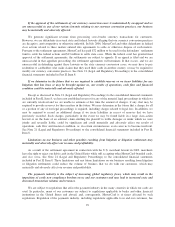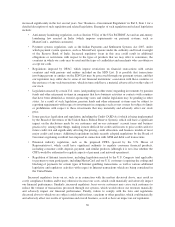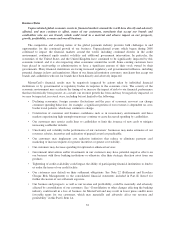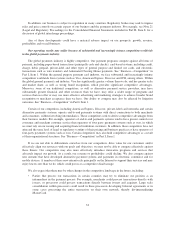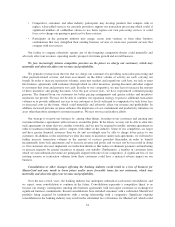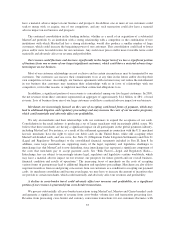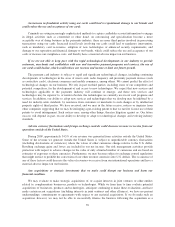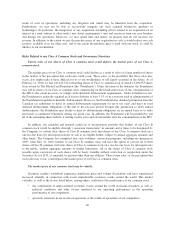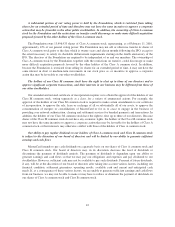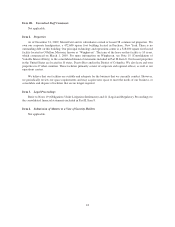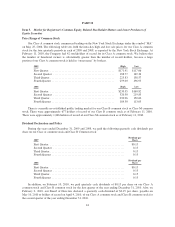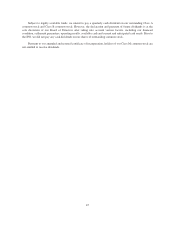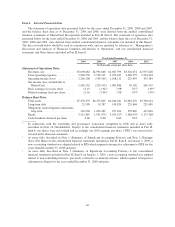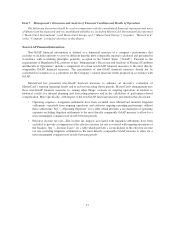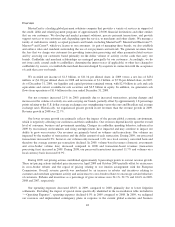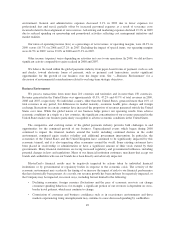MasterCard 2009 Annual Report Download - page 49
Download and view the complete annual report
Please find page 49 of the 2009 MasterCard annual report below. You can navigate through the pages in the report by either clicking on the pages listed below, or by using the keyword search tool below to find specific information within the annual report.An increase in fraudulent activity using our cards could lead to reputational damage to our brands and
could reduce the use and acceptance of our cards.
Criminals are using increasingly sophisticated methods to capture cardholder account information to engage
in illegal activities such as counterfeit or other fraud. As outsourcing and specialization become a more
acceptable way of doing business in the payments industry, there are more third parties involved in processing
transactions using our cards. Increased fraud levels involving our cards could lead to regulatory intervention,
such as mandatory card re-issuance, adoption of new technologies or enhanced security requirements, and
damage to our reputation and financial damage to our brands, which could reduce the use and acceptance of our
cards or increase our compliance costs, and thereby have a material adverse impact on our business.
If we are not able to keep pace with the rapid technological developments in our industry to provide
customers, merchants and cardholders with new and innovative payment programs and services, the use of
our cards could decline, which could reduce our revenue and income or limit our future growth.
The payment card industry is subject to rapid and significant technological changes, including continuing
developments of technologies in the areas of smart cards, radio frequency and proximity payment devices (such
as contactless cards), electronic commerce and mobile commerce, among others. We cannot predict the effect of
technological changes on our business. We rely in part on third parties, including some of our competitors and
potential competitors, for the development of and access to new technologies. We expect that new services and
technologies applicable to the payments industry will continue to emerge, and these new services and
technologies may be superior to, or render obsolete, the technologies we currently use in our card programs and
services. In addition, our ability to adopt new services and technologies that we develop may be inhibited by a
need for industry-wide standards, by resistance from customers or merchants to such changes or by intellectual
property rights of third parties. We have received, and we may in the future receive, notices or inquiries from
other companies suggesting that we may be infringing a pre-existing patent or that we need to license use of their
patents to avoid infringement. Such notices may, among other things, threaten litigation against us. Our future
success will depend, in part, on our ability to develop or adapt to technological changes and evolving industry
standards.
Adverse currency fluctuations and foreign exchange controls could decrease revenue we receive from our
operations outside of the United States.
During 2009, approximately 54.5% of our revenue was generated from activities outside the United States.
Some of the revenue we generate outside the United States is subject to unpredictable currency fluctuations
(including devaluations of currencies) where the values of other currencies change relative to the U.S. dollar.
Resulting exchange gains and losses are included in our net income. Our risk management activities provide
protection with respect to adverse changes in the value of only a limited number of currencies and are based on
estimates of exposures to these currencies. Furthermore, we may become subject to exchange control regulations
that might restrict or prohibit the conversion of our other revenue currencies into U.S. dollars. The occurrence of
any of these factors could decrease the value of revenues we receive from our international operations and have a
material adverse impact on our business.
Any acquisitions or strategic investments that we make could disrupt our business and harm our
financial condition.
We may evaluate or make strategic acquisitions of, or acquire interests in joint ventures or other entities
related to, complementary businesses, products or technologies. While we from time to time evaluate potential
acquisitions of businesses, products and technologies, anticipate continuing to make these evaluations, and have
made certain recent acquisitions (including interests in joint ventures and other alliances), we have no present
understandings, commitments or agreements with respect to any material acquisitions. If we do make such an
acquisition, however, we may not be able to successfully finance the business following the acquisition as a
39


